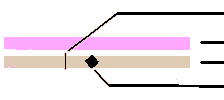Table of contents || Previous section || Previous table || Next table || Next section || Glossary || PDF document
Table of contents || Previous section || Previous table || Next table || Next section || Glossary || PDF document
EXPLANATION
 |
Guideline for the protection of aquatic life¹ Range of detections in fish tissue in all 20 NAWQA Study Units Range of detections in bed sediment in all 20 NAWQA Study Units Detection in bed sediment or fish tissue in the Red River of the North Study Unit |
|---|
| Semivolatile organic compound | Rate of detection² | Concentration, in µg/Kg |
|---|---|---|
| 1,2-Dimethylnaphthalene | -- 14% |
|
| 1,6-Dimethylnaphthalene | -- 22% |
|
| 1-Methyl-9H-fluorene | -- 14% |
|
| 1-Methyl-phenanthrene | -- 31% |
|
| 1-Methylpyrene | -- 33% |
|
| 2,2-Biquinoline | -- 6% |
|
| 2,3,6-Trimethylnaphthalene | -- 14% |
|
| 2,6-Dimethylnaphthalene | -- 47% |
|
| 2-Ethylnaphthalene | -- 19% |
|
| 2-Methylanthracene | -- 22% |
|
| 3,5-Dimethyl-phenol | -- 6% |
|
| 4,5-Methylene-phenanthrene | -- 25% |
|
| 4-Chloro-3-methylphenol | -- 3% |
|
| 9H-Carbazole | -- 44% |
|
| 9H-Fluorene | -- 44% |
|
| Acenaphthene | -- 22% |
|
| Acenaphthylene | -- 22% |
|
| Acridine | -- 6% |
|
| Anthracene | -- 47% |
|
| Anthraquinone | -- 42% |
|
| Benz[ a ]anthracene | -- 42% |
|
| Benzo[ a ]pyrene | -- 42% |
|
| Benzo[ b ]fluoranthene | -- 61% |
|
| Benzo[ ghi ]perylene | -- 17% |
|
| Benzo[ k ]fluoranthene | -- 64% |
|
| Butylbenzyl-phthalate | -- 83% |
|
| Chrysene | -- 53% |
|
| Di- n -butylphthalate | -- 97% |
|
| Di- n -octylphthalate | -- 17% |
|
| Dibenz[ a,h ]anthracene | -- 14% |
|
| Dibenzothiophene | -- 28% |
|
| Diethylphthalate | -- 81% |
|
| Dimethyl-phthalate | -- 6% |
|
| Fluoranthene | -- 83% |
|
| Indeno[1,2,3cd ]pyrene | -- 39% |
|
| Isoquinoline | -- 3% |
|
| Naphthalene | -- 8% |
|
| N-Nitrosodiphenylamine | -- 3% |
|
| Phenanthrene | -- 53% |
|
| Phenanthridine | -- 6% |
|
| Phenol | -- 81% |
|
| Pyrene | -- 86% |
|
| Quinoline | -- 3% |
|
| bis(2-Ethylhexyl)phthalate | -- 92% |
|
| p-Cresol | -- 64% |
|
| Organochlorine compound | Rate of detection² | Concentration, in µg/kg |
| total Chlordane | 9% 0% |
|
| p,p'-DDE | 73% 19% |
|
| total-DDT | 73% 22% |
|
| PCB, total | 36% 0% |
|
| Trace element | Rate of detection² | Concentration, in µg/g |
| Arsenic | 62% 100% |
|
| Cadmium | 62% 98% |
|
| Chromium | 62% 100% |
|
| Copper | 100% 100% |
|
| Lead | 13% 100% |
|
| Mercury | 86% 88% |
|
| Nickel | 13% 100% |
|
| Selenium | 100% 100% |
|
| Zinc | 100% 100% |
² Rates of detection are based on the number of analyses and detections in the Study Unit, not on national data. Rates of detection for herbicides and insecticides were computed by only counting detections equal to or greater than 0.01 µg/L in order to facilitate equal comparisons among compounds, which had widely varying detection limits. For herbicides and insecticides, a detection rate of ''<1%'' means that all detections are less than 0.01 µg/L, or the detection rate rounds to less than one percent. For other compound groups, all detections were counted and minimum detection limits for most compounds were similar to the lower end of the national ranges shown. Method detection limits for all compounds in these tables are summarized in Gilliom and others (in press).
³ Detections of these compounds are reliable, but concentrations are determined with greater uncertainty than for the other compounds and are reported as estimated values (Zaugg and others, 1995).